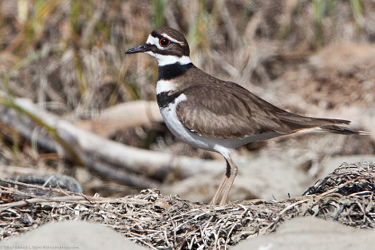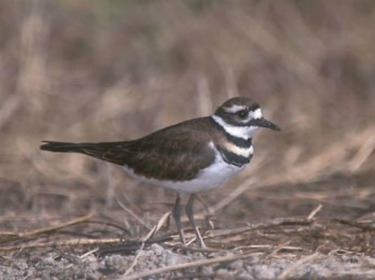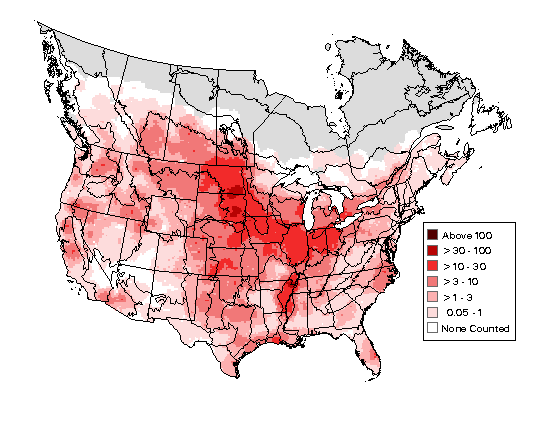Killdeer

Killdeer Information
Length: 9 - 11"
Habitat: Open habitat with some short grass - such as pastures, meadows, plowed fields, golf courses, lawns; shorelines, mudflats, coastal estuaries.
Diet: Mostly insects such as grasshoppers, beetles, and caterpillars; spiders, earthworms, centipedes, crayfish, some weed seeds.
Additional Information
KilldeerDescription, distribution, habitat, behavior, diet, reproduction, predators, and conservation status. Includes photos, sounds, and range map. (From Wikipedia)
Killdeer

Killdeer
Identification Tips
- Medium-sized, long-winged shorebird
- Short, fairly thick dark bill
- Legs flesh-colored
- Red eye ring
- White forehead and white stripe behind eye
- Brown face; black lores and upper borders to the white forehead and collar
- White collar
- Brown cap, back and wings
- White breast and belly
- Two black breast bands
- White wing stripe at the bases of the flight feathers is visible in flight
- Rust-red rump
- Brown tail with black subterminal band, white terminal band - and barred, white outer tail feathers
- Tail extends beyond wing tips at rest
- Sexes similar
- Juveniles similar to adult
Similar species:
All other plovers lack the two black breastbands. Very young Killdeer have a single breastband and could be confused with Piping, Wilson's, Snowy or Semipalmated Plovers, but are usually still downy, have black bills (any Piping or Semipalmated Plover having a breastband will also have an orange bill with a black tip), and are colored above like the adult (eliminating the paler Piping and Snowy).
(Credit: U. S. Geological Survey)
Breeding Bird Survey Map,
2011-2015

(Image credit: USGS)
Range in New England
The Killdeer
is found breeding throughout New England. This bird is said to winter in coastal areas of Massachusetts, Connecticut, and Rhode Island. However, eBird data (below) also shows winter sightings along the coasts of New Hampshire and southern Maine, as well as locally further inland.
Winter Map from eBird
Sightings of the Killdeer from
Dec-Jan over past 10 years
(2009-2019)![]()
Christmas Bird Count Map
Historical CBC Map from USGS